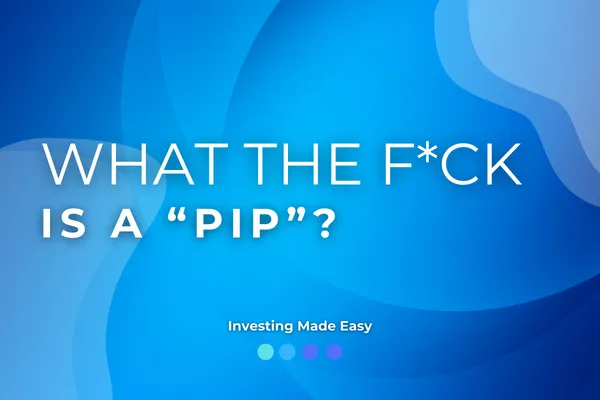
What the f*ck is a "Pip?
What is a Pip?
A pip, short for "percentage in point," is a unit of measurement used to express the change in value between two currencies in a Forex pair. It represents the smallest incremental movement in the exchange rate of a currency pair. In most currency pairs, a pip is equivalent to 0.0001, except for pairs involving the Japanese yen, where a pip is equal to 0.01.
Understanding Pip Movement:
Let's take an example to illustrate the concept of pips:
If the EUR/USD currency pair moves from 1.1200 to 1.1201, that's a one-pip movement. Similarly, if the USD/JPY pair moves from 108.50 to 108.51, that's also a one-pip movement.
Importance of Pips in Forex Trading:
Determining Profit and Loss: Pips play a crucial role in calculating profits and losses in Forex trading. The difference in pip value between the entry and exit prices of a trade determines the monetary gain or loss.
Risk Management: Understanding pip movement helps traders assess and manage their risk. By calculating the potential pip loss or gain before entering a trade, traders can set appropriate stop-loss and take-profit levels to mitigate risk.
Position Sizing: Pip values influence position sizing decisions. Traders can adjust their position sizes based on the number of pips they are willing to risk per trade, ensuring proper risk management and capital preservation.
Pipette: The Smaller Sibling of Pip
In addition to pips, Forex trading also involves "pipettes," which represent fractional pip movements. A pipette is equal to one-tenth of a pip, or 0.00001 in most currency pairs. Pipettes are particularly relevant when dealing with currency pairs that have tighter spreads or require precise price analysis.
Conclusion: Mastering the Language of Trading
Pips are the building blocks of Forex trading, serving as a standardized unit of measurement for price movements. Understanding pips allows traders to calculate profits and losses accurately, manage risk effectively, and make informed trading decisions. As you delve deeper into the world of Forex, mastering the language of pips will be essential in navigating the complexities of the market and achieving success in your trading endeavors.

What the f*ck is a "Pip?
What is a Pip?
A pip, short for "percentage in point," is a unit of measurement used to express the change in value between two currencies in a Forex pair. It represents the smallest incremental movement in the exchange rate of a currency pair. In most currency pairs, a pip is equivalent to 0.0001, except for pairs involving the Japanese yen, where a pip is equal to 0.01.
Understanding Pip Movement:
Let's take an example to illustrate the concept of pips:
If the EUR/USD currency pair moves from 1.1200 to 1.1201, that's a one-pip movement. Similarly, if the USD/JPY pair moves from 108.50 to 108.51, that's also a one-pip movement.
Importance of Pips in Forex Trading:
Determining Profit and Loss: Pips play a crucial role in calculating profits and losses in Forex trading. The difference in pip value between the entry and exit prices of a trade determines the monetary gain or loss.
Risk Management: Understanding pip movement helps traders assess and manage their risk. By calculating the potential pip loss or gain before entering a trade, traders can set appropriate stop-loss and take-profit levels to mitigate risk.
Position Sizing: Pip values influence position sizing decisions. Traders can adjust their position sizes based on the number of pips they are willing to risk per trade, ensuring proper risk management and capital preservation.
Pipette: The Smaller Sibling of Pip
In addition to pips, Forex trading also involves "pipettes," which represent fractional pip movements. A pipette is equal to one-tenth of a pip, or 0.00001 in most currency pairs. Pipettes are particularly relevant when dealing with currency pairs that have tighter spreads or require precise price analysis.
Conclusion: Mastering the Language of Trading
Pips are the building blocks of Forex trading, serving as a standardized unit of measurement for price movements. Understanding pips allows traders to calculate profits and losses accurately, manage risk effectively, and make informed trading decisions. As you delve deeper into the world of Forex, mastering the language of pips will be essential in navigating the complexities of the market and achieving success in your trading endeavors.

